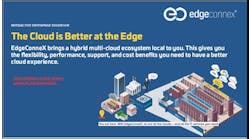Comparing Highlights from the Latest CBRE, JLL 'State of the Market' Reports for U.S. Data Centers
Two of the data center industry's foremost commercial real estate services consulting firms, CBRE and JLL, this month released their North American "state of the market" guidance regarding U.S. data center interests. Let's examine some salient points of each firm's latest analysis.
Vacancy Is Vanishing
CBRE's North America Data Center Trends H1 2024 report states that the overall vacancy rate for primary North American data center markets fell to a record-low 2.8% in H1 2024 from 3.3% a year earlier.
Meanwhile, CBRE finds the overall vacancy rate for secondary markets fell to 9.7% from 12.7% over the past year.
Similarly, JLL's U.S. Data Center Report H1 2024 report notes that while the U.S. colocation data center market has amazingly doubled in size in just four years, vacancy is at a new record low of 3% amid insatiable demand.
Supply On the Rise
At midyear 2024, JLL found that the existing supply of colocation data center capacity in the U.S. stood at 12 GW. JLL further finds that U.S. data center occupancy has increased at a 30% CAGR since 2020.
CBRE stated that supply in primary North American markets increased by 10% or 515.0 megawatts (MW) in H1 2024, and by 24% or 1,100.5 MW year-over-year.
In terms of inventory, JLL notes that as a result of proportional expansion, the ratio of inventory between primary and secondary markets has remained roughly unchanged in recent years, with its analysis finding that currently 76% of total colocation capacity resides in primary markets and 24% in secondary markets.
Pricing and Leasing Check
With an 84% rate of preleasing, JLL reports that asking rents for U.S. data centers have increased between 13% and 37% year-over-year depending on the lease size.
For its part CBRE's analysis confirms that pricing in North American data centers continued to increase, albeit at a slower rate than last year.
CBRE reports the average monthly asking rate for a 250- to 500-kilowatt (kW) requirement across primary North American data center markets increased by 7% in H1 2024 to $174.06 per kW/month.
One standout CBRE data point in this area is how Atlanta led all primary U.S. data center markets with a 26% year-over-year increase in pricing, largely due to strong demand from AI providers.
CBRE notes that rental rates in North American data centers are expected to increase further in H2 2024 due to rising construction and equipment costs.
Record-High U.S. Data Center Construction
In the area of data center construction, CBRE says that under-construction activity in primary markets hit a record-high 3,871.8 MW in H1 2024, up by 69% from a year earlier.
Notwithstanding, the firm finds that a shortage of available power and longer lead times for electrical infrastructure continued to delay construction completions.
In terms of the hottest markets for U.S. data center development, CBRE reports that Atlanta's under-construction activity increased by 76% year-over-year to 1,289.1 MW.
Meanwhile in the perennial national data center hotspot of Texas, Austin and San Antonio’s combined under-construction activity reportedly more than quadrupled from a year ago to 463.5 MW.
Similar to JLL's findings, CBRE finds that nearly 80% or 3,056.4 of the 3,871.8 MW under construction in primary markets for H1 2024 was preleased.
While cloud providers continued to lease most available power capacity, CBRE emphasizes that artificial intelligence (AI) providers also accounted for a considerable amount of demand.
While admitting that U.S. data center construction continued at an extraordinary pace in H1 2024, JLL notes that colocation capacity under construction leveled off in the first half of 2024 at 5.3 GW, a potential signal that the U.S. power grid cannot support development at a faster pace.
Notwithstanding, JLL reports that U.S. data center construction has increased by more than seven times in the past two years.
JLL affirmed that Atlanta has become the leader in colocation capacity under construction for the first time following several years of heightened investor
interest.
NoVA Constraints
Interestingly, JLL's report found that Northern Virginia, the perennial top U.S. market for construction, slipped to fifth place in colocation capacity under construction amid power grid constraints.
To wit, Bloomberg this week reported that some Virginia data center developers are facing a seven-year wait for power hookups from Dominion Energy. Importantly, Dominion said data center projects already evaluated won’t see a longer wait. Virginia electrical connections previously took as long as four years, noted the report.
Stan Blackwell, Dominion Energy's Director of Customer Solutions & Strategic Partnerships, will be participating on the opening keynote panel of the Data Center Frontier Trends Summit in Reston, Virginia, next Wednesday, Sept. 4.
JLL concludes that the pipeline of planned U.S. colocation developments nearly doubled in the first half of 2024 to 22 GW, and that with the completion of all projects currently under construction or planned, the U.S. colocation market can expect a tripling in size from current levels.
Power Availability Is First Concern
CBRE's North America Data Center Trends H1 2024 analysis affirms that power availability remained the top consideration in data center site selection.
For it's part, JLL's report grapples with increasing concerns that the U.S. power grid is running out of power due in part to the rapid growth of data centers.
It's important to note that while data center power demand has been growing at a 21% CAGR in recent years, the sector only accounted for about 3% of total U.S. power in 2023.
However, if trendlines hold, JLL projects that percentage to surpass 11% in the next decade.
CBRE expects that power delivery timelines will continue to increase in H2 2024 due to a shortage of readily available equipment, such as transformers, switches and generators.
The firm predicts that difficulty in procuring critical equipment will lead to power delivery delays of up to four years.

Matt Vincent
A B2B technology journalist and editor with more than two decades of experience, Matt Vincent is Editor in Chief of Data Center Frontier.





